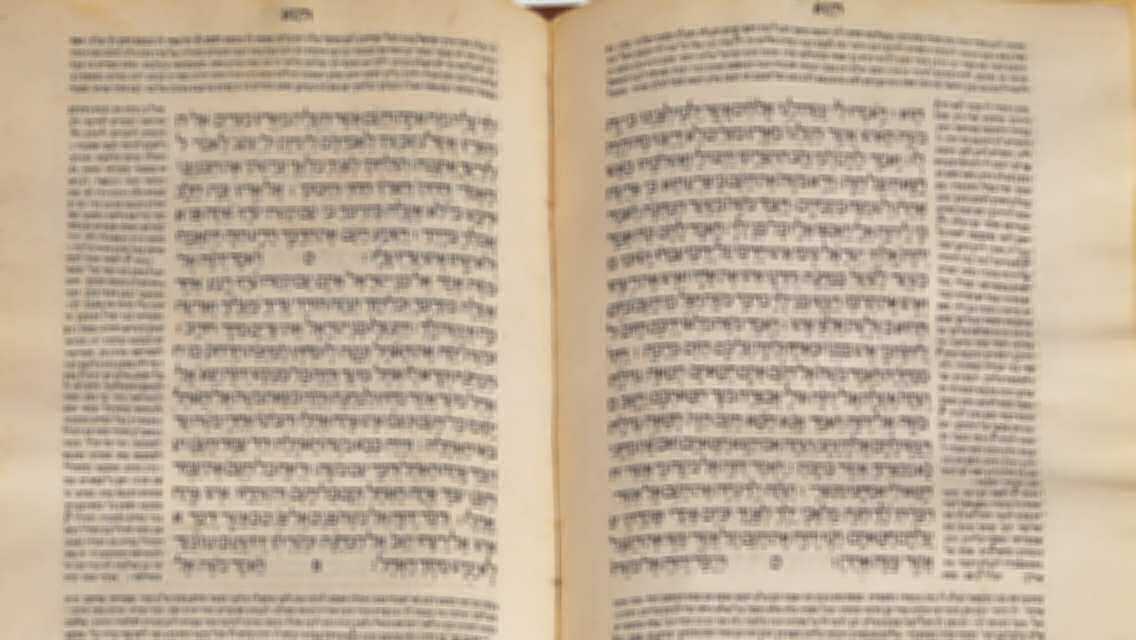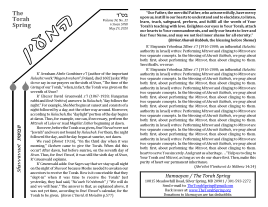This Week’s Sponsors
Sponsored by
Zev and Marlene Teichman
on the yahrzeit of Zev's mother
Leah bas Moshe Meyer a”h, on 17 Elul
Irving and Arline Katz
on the yahrzeit of her father
Moshe Aharon ben Menashe Yaakov Reiss a”h
This week’s Parashah begins with the Mitzvah of bringing Bikkurim / First Fruits to the Bet Hamikdash. Midrash Rabbah states that the world was created in the merit of this Mitzvah. Midrash Sifrei says that the Jewish People entered Eretz Yisrael in the merit of this Mitzvah. What exactly is so special about the Mitzvah of bringing Bikkurim to the Temple?
R’ Shmuel Berezovsky shlita (Slonimer Rebbe in Yerushalayim) explains: We read (Yeshayah 28:4), “Like a fig that ripens before summer: as soon as an observer sees it, while it is yet in his hand, he swallows it.” When a person sees the first figs ripening on his trees at the beginning of the summer, the temptation to eat them is enormous. One can nearly lose his senses, so great is that desire: “while it is yet in his hand, he swallows it.”
Nevertheless, what does a Jew do? He sets aside that fig for Bikkurim, thus “handing over” that immense desire to G-d. This, writes the Slonimer Rebbe, is the choicest of all forms of Divine service. It is the reason the world was created and the purpose for which Eretz Yisrael was given to the Jewish People. The goal of all Divine service is to crown Hashem as King of the world, until there is no part of a person’s body and no experience in life over which G-d does not reign. This is what a person does when he brings Bikkurim, which is what makes that Mitzvah so special.
The Mishnah (Bikkurim 3:1) teaches: “How are Bikkurim set aside? A person goes down to his field and sees the first fig . . .” Why is going to the field called “going down”? Because the farmer first “lowers himself” into a situation in which he is tested by temptation. Later, though, he elevates himself immeasurably by designating his first fruits as Bikkurim. (Darchei Noam 5764)
“Then we cried out to Hashem, the Elokim of our forefathers, and Hashem heard our voice and saw our affliction, our travail, and La’chatzeinu / our oppression.” (26:7)
R’ Eliyahu z”l (1720-1797; the Vilna Gaon) explains the word “La’chatzeinu” as meaning that the Egyptians deprived Bnei Yisrael of proper living quarters--a proper dwelling being one of the three things that our Sages say give a person piece of mind.
R’ Yitzchak Arieli z”l (1896-1974; Mashgiach of Yeshivat Merkaz Harav; author of Enayim La’mishpat) observes: Not having a proper dwelling seems insignificant compared to the physical enslavement to which our ancestors were subjected. Nevertheless, Hashem is referred to as “The Rock! -- perfect is His work” (Devarim 32:4). His justice is very precise, so when it was time for Him to “remember” Bnei Yisrael, He took notice of even the smallest detail of their suffering. (Haggadah Shel Pesach Shirat Ha’geulah p.62-63)
“Hashem took us out of Egypt with a strong hand and with an outstretched arm, with great awesomeness, and with signs and with wonders.” (26:8)
In the Pesach Haggadah, our Sages interpret this verse as teaching that Hashem alone took us out of Egypt, not through the agency of an angel or messenger. In support of that interpretation, the Haggadah cites the verse (Shmot 12:12), “I shall go through Egypt on this night, and I shall strike every firstborn in the land of Egypt, from man to beast; and against all the gods of Egypt I shall mete out punishment -- I am Hashem.” I, Hashem, and no one else! says the Haggadah.
R’ Shmuel Yaakov Borenstein z”l (1946-2017; Rosh Yeshiva of Yeshivat Kiryat Melech in Bnei Brak, Israel) asks: The latter verse does not seem to be speaking of the Exodus, but rather of Makkat Bechorot / the Plague of the Firstborn. How then does it support the idea that Hashem alone took us out of Egypt, which is the subject of our verse?
R’ Borenstein answers: Makkat Bechorot was not merely a plague like the other plagues. Rather, it was the beginning of the Exodus.
He explains: Our Sages describe the process of the Exodus as a “birth.” The long exile had caused Bnei Yisrael to become as one with the Egyptians--as a fetus inside a mother sheep is, Halachically, part of the sheep--and Hashem “birthed” them. When did this “birth” occur? At the time of Makkat Bechorot! Egypt had subdued the spirit of Bnei Yisrael, making them a slavish people by nature. But, when the venerated firstborn of the Egyptians were killed, the spirit of the Egyptians was broken, and the spirit of Bnei Yisrael was freed from its bondage. That was the beginning of the Exodus, because the Exodus was more than just salvation from physical bondage. Makkat Bechorot freed Bnei Yisrael’s from their spiritual bondage; thus, it was a key part of the Exodus itself. (Haggadah Shel Pesach Zot L’Yaakov p.121)
“You will go mad from the sight of your eyes that you will see.” (28:34)
R’ Yosef Yozel Horowitz z”l (1847-1919; the Alter of Novardok) writes: The “sight of your eyes” that will drive a person mad refers to seeing one’s own good qualities. He explains:
The Gemara (Bava Batra 78b) teaches that the key to controlling one’s Yetzer Ha’ra is performing a Cheshbon Ha’nefesh / self-assessment (literally, “accounting of the soul”). Everyone performs assessments and accountings, the Alter notes: They balance their checkbooks and decide what purchases they can afford or not afford; they take their temperatures and decide whether they need medicine; etc. Yet, most people find it difficult to perform a Cheshbon Ha’nefesh / an accounting of their behavior and thoughts. Why?
He answers: It is easy to recognize a Rasha / wicked person. Most people have no trouble avoiding people or behaviors that are undeniably wicked. However, if the wicked person wears the garb, has the mannerisms, and speaks the language of a Talmid Chacham / Torah scholar, the danger he presents is enormous. Such a person is difficult to recognize for what he really is.
Similarly, if an otherwise observant Jew has a regular yearning for one particular non-kosher dish, he will have no trouble recognizing that as a failing. Even if he cannot control it, he will make sure that it does not affect other areas of his observance. Generally, however, people are not accustomed to looking at their good qualities and bad qualities separately. Instead, they weave their good qualities and bad qualities into one “picture” of themselves. They combine black and white to create gray, rather than addressing the black and the white separately. Worse yet, they alter their view of what is good to accommodate their failings. In this sense, being aware of their own good qualities has driven them “mad.”
Some bad qualities may seem very insignificant, the Alter notes. However, if one takes a valid one dollar bill and adds a zero--i.e., nothing--to the denomination, the result is equivalent to a counterfeit ten dollar bill. So, too, even minor bad qualities that are woven into a good lifestyle can create a corrupt lifestyle. What is the source of this mistake? It is that most people see righteousness and wickedness as absolutes, not appreciating that there are an infinite number of levels between a Tzaddik and a Rasha. Thus, one who sees himself as essentially righteous thinks he has nothing to worry about. But he is wrong, writes the Alter. A person is always on a slope, either going up or going down. Every bad quality takes a person at least one step down the slope, farther from being a Tzaddik and closer to being a Rasha. That is why no bad quality should be ignored. (Madregat Ha’adam p.136)
Elul: Breaking Habits
R’ Chaim Friedlander z”l (1923-1986; Mashgiach Ruchani of the Ponovezh Yeshiva) writes: Elul is a time when Hashem comes closer to us and gives us the opportunity to come closer to Him than we can during the rest of the year. This is the meaning of our Sages’ teaching that the initial (Hebrew) letters of the words in the verse (Shir Ha’shirim 6:3), “Ani l’Dodi v’Dodi li” / “I [belong] to my Beloved, and my Beloved [belongs] to me,” spell “Elul.” Of course, feeling closeness requires that both sides contribute. Therefore, it is incumbent upon us not to squander the opportunity.
What holds us back from coming closer to Hashem? R’ Friedlander answers: One of the primary obstacles is habit. The Gemara (Sukkah 52a) teaches that at some time in the future, the Yetzer Ha’ra will be “Shechted” and eulogized. [Commentaries explain that there will be an element of sorrow because, when this happens, we will have lost the opportunity to be challenged by, and to overcome, the Yetzer Ha’ra.] At that eulogy, says the Gemara, men and women will stand separately. Why? asks R’ Friedlander. Once there is no Yetzer Ha’ra, when mankind has returned to the level of Adam Ha’rishon before his sin, why will it be necessary for men and women to be separated? The answer, writes R’ Friedlander, is that habit is so powerful that it can even cause a person who has no Yetzer Ha’ra to sin!
He continues: In this light, we can understand the widespread custom to eat only bread baked by Jews during the Ten Days of Repentance. Many ask: What is the purpose of adopting a Halachic stringency for ten days, when G-d and I both know that I have no intention of maintaining that level of observance? The answer, R’ Friedlander writes, is that any breaking of habits, even for a short time, is a valuable exercise that assists a person in improving in other areas.
What other practical steps should a person adopt to further the goals of Elul? R’ Friedlander answers: First and foremost, one should improve his Davening; for example, by coming on time and saying the words out loud. Also very beneficial are performing acts of kindness and studying Mussar / works about character improvement. (Siftei Chaim: Mo’adim I p.46)
Find Other Issues
Hama'ayan's archives are being rebuilt. Check back soon.

